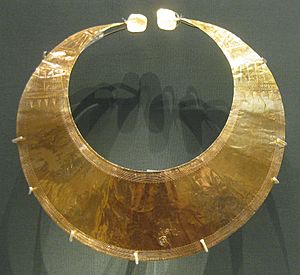Coggalbeg hoard facts for kids
The Coggalbeg hoard is a special collection of gold jewelry from the Bronze Age. This means it is very old, dating back to about 2300 to 2000 BC! It was found in 1945 in a bog (a type of wetland) in Coggalbeg, a place in County Roscommon, Ireland.
The hoard includes three main pieces. There is a beautiful gold lunula, which is a flat, crescent-shaped piece of gold. Its name means "little moon" because of its shape. There are also two small gold discs. These discs have a cool design with a cross inside two circles. All the pieces are thin and light, weighing less than 78 grams. This suggests they were probably worn together as part of a necklace.
Discovery of the Hoard
The Coggalbeg hoard was first found in 1945. A man named Hubert Lannon discovered it while he was cutting turf in his bog. Turf is a type of fuel, like peat, that people dig from bogs.
After its discovery, the hoard was kept safe for many years. It was stored in a safe at a pharmacy in a town called Strokestown. Only the family who owned the pharmacy knew about it.
The Hoard's Journey to the Museum
In 2009, the safe where the hoard was kept was stolen from the pharmacy. The thieves were probably looking for money. They didn't realize the gold items were so valuable. The Garda Síochána (the Irish police) later found the objects. They were wrapped in paper and left in a rubbish skip. The police believe the thieves didn't care about the light gold pieces.
Today, the Coggalbeg hoard is a very important part of Ireland's history. It is now kept at the National Museum of Ireland. You can see it there on permanent display.
Why the Hoard is Special
Experts at the museum say the Coggalbeg hoard is very important. It is the only known time that these gold discs and a lunula have been found together. The gold discs are thought to be some of the oldest gold ornaments ever found. The lunula came a little bit later in time.
Ireland is famous for its ancient gold. Out of about 100 lunulae found in Western Europe, around 80 of them come from Ireland! This shows how skilled ancient Irish people were with gold.
In 2017, the three gold pieces from the Coggalbeg hoard were even featured on an Irish postal stamp. This was part of a special series called A History of Ireland in 100 Objects. It shows how much these ancient treasures mean to Ireland's heritage.


